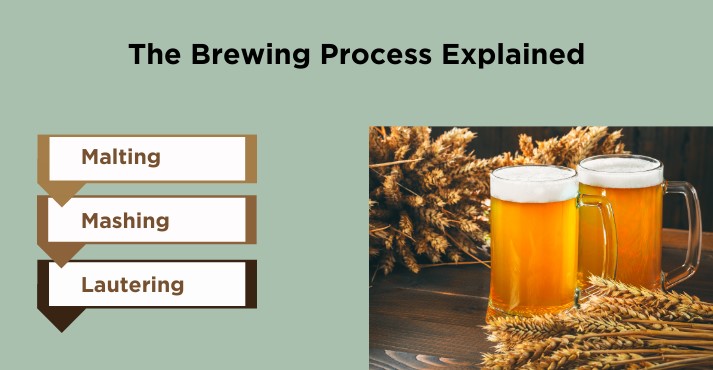In the brewing process, grains, water, hops, and yeast combine to create a refreshing glass of beer. A crucial ingredient known as wort also plays a key role in beer brewing.
Beer wort is the liquid foundation of beer, derived from boiling malted grains with hot water to extract their sugars.
This sugary liquid then undergoes fermentation, where yeast converts the sugars into alcohol and carbon dioxide, resulting in beer.
Wort is essential to brewing because it directly influences the final product’s flavor, aroma, and color.
The composition of wort, including its sweetness, bitterness, and body, determines how the beer will taste and smell.
Whether you’re brewing an IPA or a stout, the quality and characteristics of the wort play an essential role in shaping the beer’s profile.
For those in the brewing industry, understanding wort’s role and how to control its composition is critical to crafting high-quality beers.
From selecting the right malts to perfecting the boiling process, every step in wort preparation impacts the final product.
The Birth of Wort: Brewing Process Explained

The transition of raw ingredients to beer begins with a fundamental component known as wort. This sugary liquid forms the base of all beers. Here’s a detailed look at the process of wort production:
1. Malting
The brewing process starts with malting, where barley grains are soaked in water to begin germination. This is also the first step to producing grain alcohol and draft beer.
As the grains sprout, enzymes activate, converting the stored starches into fermentable sugars. This stage is crucial as it prepares the grains to provide the necessary sugars for fermentation.
After germination, the malted barley is dried in a kiln, halting germination and stabilizing the grains.
2. Mashing
Next comes mashing, where the malted grains are crushed into a coarse grist powder. The grist is then mixed with hot water in a process known as steeping.
This mixture, known as the mash, allows the enzymes to break down the starches into fermentable sugars further.
The result is a sugary liquid called wort. The temperature and duration of mashing can influence the sweetness and body of the final beer.
3. Lautering
Following mashing is lautering, where the wort is separated from the solid remains of the grains, known as the spent grains.
The mash is transferred to a lauter tun, which filters the wort through a false bottom or slotted plate.
The liquid wort is then drained off and collected. Hot water is sprayed over the grains sparingly to ensure maximum sugar extraction.
Types of Wort
There are various types of wort, each contributing unique qualities to the beer.
1. Pale wort: It is light in color and typically used in lighter beer styles like lagers and pale ales.
2. Amber wort: It has a deeper color and imparts a richer flavor. It is used in amber ales and some IPAs.
3. Crystal wort: It is made from roasted malt, is dark in color, and has caramelized flavors. It is suitable for stouts and porters.
Each type of wort influences the beer’s final taste, color, and aroma, making it a crucial aspect of brewing. Differentiating between these variations helps brewers craft beers with specific profiles and qualities, ensuring that each batch meets their desired standards.
The Science Behind Wort: Sweet Secrets

The science behind wort can help you understand why it’s essential in brewing and how it influences the final beer. Wort’s composition shapes the beer’s flavor, body, and stability.
Sugars
The primary role of wort is to provide fermentable sugars, which yeast converts into alcohol and carbon dioxide. The main sugars in the wort are maltose and maltotriose, both derived from the breakdown of starches during mashing.
Maltose is the most fermentable sugar, making up most of the wort’s sugar content. Maltotriose is also fermentable but less so than maltose.
These sugars feed the yeast, influencing the beer’s alcohol content and carbonation. The wort’s specific sugar profile can impact the beer’s sweetness, dryness, and overall balance.
Proteins
Proteins in the wort, primarily from the malted grains, contribute to various beer characteristics. During brewing, proteins help form and stabilize the beer’s foam and impact its body and mouthfeel.
Adequate protein levels can enhance head retention, giving the beer a pleasing, creamy foam that enhances the drinking experience. However, excess proteins can lead to haze, which might be undesirable in certain styles.
Other Components
Wort contains various other components that influence the final beer. Minerals such as calcium and magnesium play a role in enzyme activity during mashing and affect the beer’s flavor and stability.
Vitamins from the grains can also contribute to yeast health during fermentation. Additionally, while hops are not part of the wort initially, they are added later in the brewing process.
Hops impart bitterness, aroma, and flavor to the beer, balancing the sweetness of the wort and contributing to the overall profile.
The science of wort is about more than just sugars. Its protein content, mineral composition, and interaction with hops all play vital roles in crafting the final product.
By focusing on these components, brewers can better control the brewing process and produce desired characteristics and quality beers.
From Wort to Beer: The Power of Fermentation

Once the wort is prepared, it undergoes a crucial transformation into beer through fermentation.
The key player in this stage is yeast, a microorganism that converts the sugars in wort into alcohol and carbon dioxide.
When added to the cooled wort, yeast consumes the fermentable sugars, primarily maltose and maltotriose.
As the yeast metabolizes these sugars, it produces alcohol, which provides the beer’s alcoholic content, and carbon dioxide, which creates fizzy beer and bubbles.
The composition of the wort significantly influences the final beer style. For instance, the sugar content in the wort determines the alcohol level, while the hop character can affect bitterness and aroma.
The balance of these elements shapes the beer’s overall profile, including its sweetness, dryness, and flavor complexity. Thus, the quality and characteristics of the wort play a foundational role in defining the style and taste of the finished beer.
Conclusion
Wort is an essential component of the brewing process, serving as the precursor to beer. Understanding how beer wort is created, from malting to mashing to lautering, provides insight into its role in brewing.
The composition of wort, including its sugars, proteins, and other components, impacts the final product, influencing everything from flavor and aroma to body and stability.
As wort transitions into beer through fermentation, yeast plays a considerable role, converting sugars into alcohol and carbon dioxide. This process highlights the critical connection between the wort’s composition and the beer’s final characteristics.
The balance of sugars, the presence of proteins, and the addition of hops all contribute to crafting a beer that meets the desired profile and quality.
For brewers and beer enthusiasts alike, appreciating the food science and art behind wort and its conversion into beer enhances the brewing experience. It helps you appreciate the trends in the Asian food and beverage industry.
Whether a seasoned professional or a curious beginner, grasping these fundamentals improves your ability to create and enjoy a diverse range of beers.





























